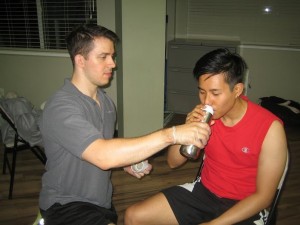
Heat emergencies are caused by prolonged exposure to hot weather or extreme heat. Other causes include excessive exercise, dehydration, heart disease, sweat gland problems and wearing too much clothing. There are three categories that occur in increasing severity and becomes more worrisome, heat cramps, heat exhaustion, and heatstroke. Although it can occur to anyone, including athletes, those who are at greater risk for developing heat illnesses are children, elderly and obese people. In addition, people taking certain medications or drinking alcohol are also at greater risk.
Heat Emergencies: Heat Cramps
Heat cramps is the first in the spectrum of heat emergencies and is the least dangerous, but nonetheless still considered serious.
- Usually caused by being physical active in the heat
- Signs and symptoms: muscle pain and tightness
- First Aid:
- Move the individual to a cooler area and out of the direct heat of the sun
- Slightly massage the cramping muscle
- Assist and encourage the individual to gently stretch the muscle
- Give cool water or sports drinks every 15 minutes
Heat Emergencies: Heat Exhaustion
If heat cramps is not addressed, it can develop to heat exhaustion.
- Usually caused by dehydration
- Signs and symptoms: muscle cramps, dizziness, headache, nausea and vomiting, extreme thirst, pal skin, heavy sweating, fainting and irritability
- First aid:
- Move the individual to a cooler area and out of the direct heat of the sun
- Loosen clothing, especially any tight clothing
- Apply cool, wet towels to the face, neck, chest and limbs
- Fan the individual’s skin
- Give cool water or sports drinks every 15 minutes and avoid drinking too fast
Heat Emergencies: Heatstroke
Heatstroke is the most serious among all categories and is considered a life-threatening medical emergency. When one experiences symptoms of heatstroke, call for emergency medical services immediately.
- Signs and symptoms: all aforementioned in heat exhaustion plus body temperature over 40°C, confusion, irrational behaviour, rapid and shallow breathing, rapid and weak pulse, seizures and loss of consciousness
- First aid:
- Move the individual to a cooler area and out of the direct heat of the sun
- Loosen clothing, especially any tight clothing, and remove any clothing drenched in sweat
- Apply cool, wet towels to the face, neck, chest and limbs. If ice is present, wrap in a towel or any piece of clothing and place in the wrists, underarms, and groin
- Fan the individual’s skin
- If the individual is conscious, give cool water or sports drinks every 15 minutes
Giving first aid to any of the three categories of heat emergencies is necessary to avoid any life threatening scenarios. The earlier it is recognized, the higher the chances of avoiding any complication. To learn how to effectively manage heat emergencies, whether heat cramps, heat exhaustion or heatstroke, enroll in First Aid Courses.
Online Sources:
